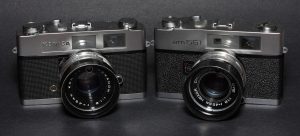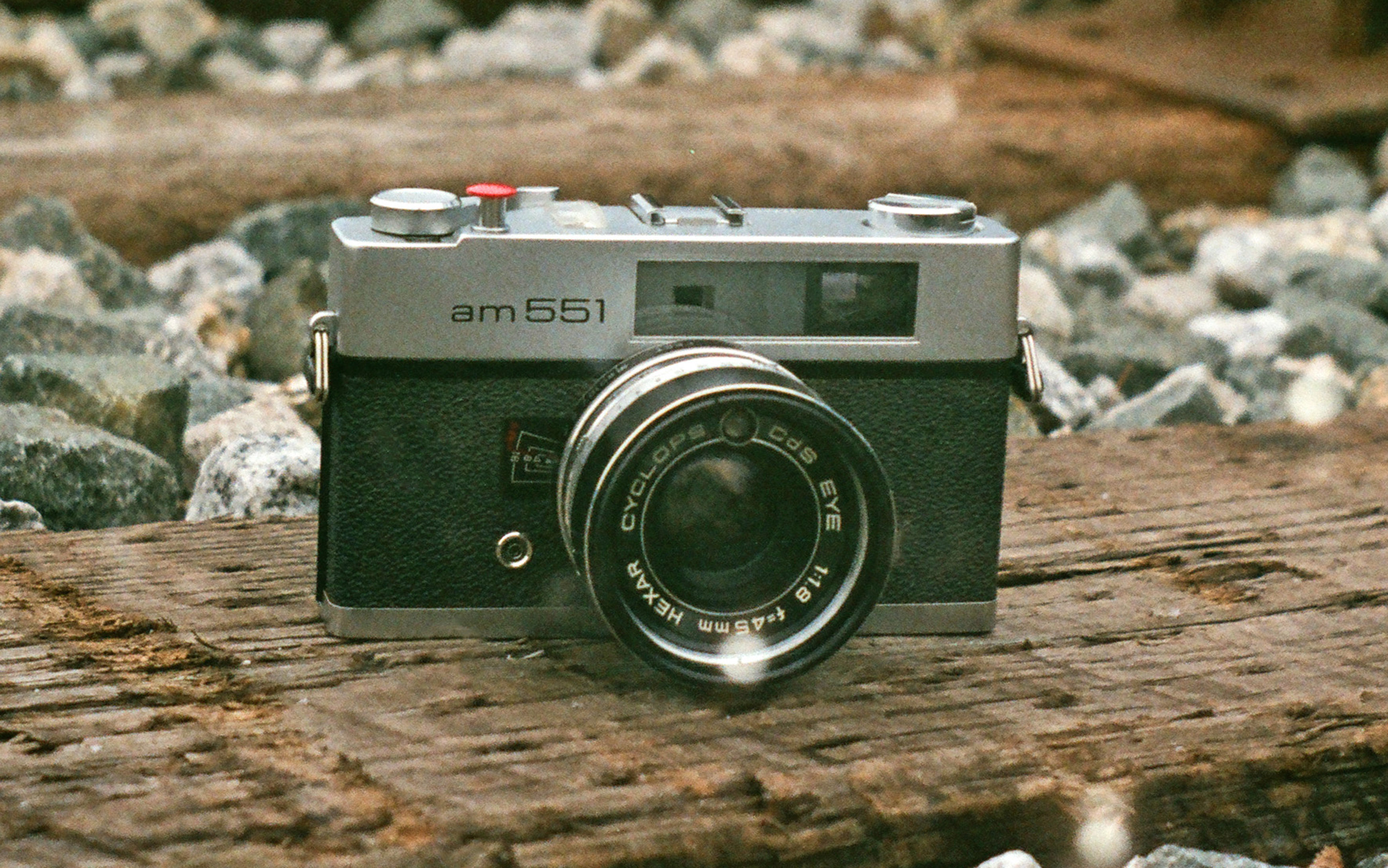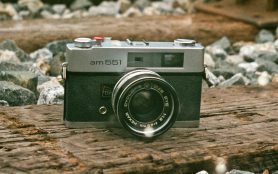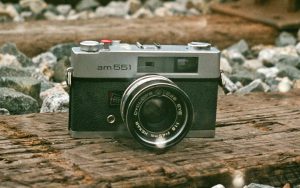This is a Wards am551 rangefinder camera sold by the Montgomery Wards chain of department stores. This camera is a rebadged Konica Auto S2 which was a very nice Japanese rangefinder of the mid 60s. Back in those days, it was common for major American department stores to sell copies of existing cameras under their own brand.
Film Type: 135 (35mm)
Lens: 45mm f/1.8 coated Hexar 6 elements
Focus: ?? to Infinity
Type: Coupled Rangefinder
Shutter: Copal SVA Leaf
Speeds: B, 1 – 1/500 seconds
Exposure Meter: Coupled CdS Lens Mounted
Battery: PX625 Mercury replacement
Flash Mount: Coldshoe and PC Sync
Manual: http://butkus.org/chinon/konica/konica_auto_s2/konica_auto_s2.htm
History
As the years go by, more and more commerce is done online from places like Amazon.com and the many other online e-tailers. While many people still shop at brick and mortar stores, the role of the major department store is becoming less and less important.
Young people today don’t remember a time where if you needed something for your home, whether it was clothing, jewelry, furniture, appliances, or electronics, you went to one of the major department stores like Sears, JCPenney, Marshall Fields, or Montgomery Wards. Often times, major shopping areas were built around one of these anchor stores. When the rise of the indoor mall hit its peak in the late 70s, 80s, and early 90s, it was common to see these same names over and over across the country.
These big department stores sold everything, and although they offered many of the major name brands of the day, it was very common for a department store chain to offer their own house brand of their products as well. While it might not be too difficult for a chain like Montgomery Wards to create their own clothing lines or housewares division, these chains lacked the expertise to create their own cameras and other types of electronics. So, what would typically happen is that a chain would partner with an established company and sell rebadged copies of already current models, but under that chain’s own name. Other than the nameplate, these cameras were identical in every way to the cameras that they were based off.

For cameras, Wards retained their “Wards” label, while Sears Roebuck sold cameras under their “Tower” label. This camera is officially called a Wards am551 from 1965, but its really just a rebadged Konica Auto S2. The Auto S2 was a popular camera in the mid 1960s due to its solid build quality and very sharp 45mm f/1.8 Hexar lens. These days its not too hard to find Auto S2s still in good working condition, but to find this Wards variant is much harder. I actually stumbled upon this camera and knowing that it was really a Konica Auto S2, I picked it up for $10 on eBay which is easily $20-$30 cheaper than genuine Auto S2s would typically sell for. There isn’t a lot of info out there about this Wards variant, but as best as I can tell, it was only available in 1965.
Although Konica no longer makes cameras, they were the very first Japanese camera maker. The company could trace its roots all the way back to a man named Sugiura Rokusaburo who in 1873 sold pharmacy supplies in Tokyo, Japan. Sugiura launched his own pharmacy company, named Konishi Honten in 1878. In 1882, the company began producing its own photographic materials and selling them to other Japanese companies. 20 years later, Konishi sold the Cherry Portable Camera, which was the very first Japanese made consumer camera.
Over the next 2 decades, Konishi Honten did very well and in 1921, the company was renamed G.K. Konishiroku Honten. The company continued to be successful throughout the 20s, releasing several other lines of cameras and even founded the Konishi College of Photography in 1923. In 1931, the company released the first ever commercially available Japanese camera lens, known as the Hexar.
Between the years of 1936 and 1943, as Japan became increasingly involved in World War II, the company’s business became reorganized and the name changed several times. At one point their entire retail and wholesale business was stopped.
After the war, the Japanese company hoped to expand their sales outside of Japan, so their name was changed once again to incorporate English, and now they were known as Konishiroku Photo Industry Co., Ltd. In 1947, the company released a clone of the German Leica camera and gave it the name “Konica”.
Shortly after the war, most Japanese companies struggled to succeed outside of their home country as the world was not ready to trust in Japanese made products. In the years that followed, Konishiroku’s strict attention to quality control and positive reputation eventually pushed them into the forefront of the photographic world.
In 1959, Konishiroku released a new 35mm rangefinder camera called the Konica S. It was the company’s first camera to feature a coupled selenium light meter. It also came with a Hexar 45mm f/2.8 lens. The Konica S was a huge hit, both in Japan and overseas. In 1963, the Konica Auto S was released with an upgraded CdS light meter, an Auto-Exposure mode, a pull out lens hood, and a faster 5 element 47mm f/1.9 lens.
The Konica Auto S was the first Konishiroku camera to be sold at Montgomery Wards as the rebadged Wards am450 and am550. The Auto S sold very well all around the world and continued to build upon Konishiroku’s reputation as a premiere Japanese camera maker.
Not content to sit on its achievements, Konica continued to upgrade the camera, and in 1965 released the Auto S2, which further upgraded the lens to a 6 element 45mm f/1.8 design. The new model also added parallax correction to the rangefinder and moved the CdS light meter to the actual lens which meant that you could attach filters to the camera and the light meter would adjust its settings depending on the situation. This model was also sold at Wards as the am551.
The Konica Auto S line continued to be popular with the Auto S1.6 from 1969 which featured a 50mm f/1.6 Hexar lens, and then the completely redesigned Auto S3 in 1973.
Konishiroku’s cameras continued to sell well throughout the entire 60s and into the 1970s. In 1972, the company’s name changed once again to K.K. Yamanashi Konica, which for the first time incorporated “Konica” into the company name. In 1983, the company adopted the name Konica Electronics for business outside of Japan.
Prior to the 1960s, Konica was one of the most successful Japanese camera companies, but increased competition from other Japanese camera makers like Nikon, Canon, Yashica, and Minolta started to dilute their sales. Although I cannot find any evidence of this, I assume that Konica’s partnership with Wards was a way of increasing their sales penetration into markets like the United States who was still hesitant to fully embrace Japanese made products.
As the 1970s came and went, SLR cameras became the preferred style of camera for professional and amateur photographers. The number of rangefinder models started to dwindle, eventually being seen as an entry level camera. Although Konica released a series of SLRs that sold moderately well in the 70s and 80s, they never achieved the same level of success as Canon and Nikon’s SLRs. By the late 80s and into the 90s, Konica became known for their small point and shoot autofocus cameras. In 2003, due to dwindling sales, Konica merged with Minolta forming the Konica Minolta Holdings corporation and in 2006, sold off all of its photography assets to Sony.
Today, the Auto S2 is looked back as one of the most desirable 60s 35mm rangefinder cameras for collectors. The cameras were built incredibly well and the Hexar lens was as good as they came. The Auto S2’s closest competitor was Canon’s Canonet line of rangefinders. Both the Auto S2 and Canonet QL17 and QL19 were about the same size, offered both auto and full manual modes, featured a coupled CdS light meter in the lens, and fast, sharp lenses. Although the Wards am551 is literally the same exact camera as the Auto S2, it is not as well known and therefore when copies do show up on the used market, they often sell for quite a bit cheaper than their Konica counterparts.
My Thoughts
I received this camera after I already had my Yashica Electro. At a glance, the Wards am551/Konica Auto S2 are very similar. Both are examples of mid 60s to early 70s rangefinder design, both are approximately the same size and weight, and both have very sharp and very bright lenses which are capable of wonderful shots. This camera offers both aperture and shutter speed selection which means it is capable of full manual control whereas the Yashica is only aperture priority. This camera also does not require a battery for the shutter to work, whereas the Yashica needs a working battery to function at anything other than 1/500 sec.
I still really love my Yashica Electro, but wanted to try out another example of this style of camera, and the Canonet’s are still so expensive, so when I saw this one going for only a couple of bucks on ebay, I took a shot at it!
Mine came in excellent shape with only a few minor quirks. One, which I’ve actually read about on some other forums, is that the lens appears to be loose. I am not sure if this is something that this camera is prone to over time, or if thats just “how it is”, but there seems to be a little bit of play in the lens. The lens on this camera is not interchangeable, so it really shouldn’t be loose at all. Its far from wobbly, and I don’t think that it has any impact on the outcome of the pictures, but its worth mentioning.
One feature that is unique to this camera is an integrated lens hood, which is nothing more than a plastic ring that slides forward and backward in front of the lens element. It feels kinda cheap, and I’m not sure how effective it is, but its there in case you need it.
Another thing thats worth mentioning is that inside of the viewfinder, you can see an aperture scale. When the meter is working, you see a moving needle which points to the aperture setting the camera is selecting based on the available light. On mine I see the needle move, but its very hard to see. This could be an issue because I wear prescription glasses, but I struggle to look up in the viewfinder to actually see the scale and needle. It is easier to see in bright outdoor light, but indoors where lighting isn’t the best its almost impossible to see. If you really struggle with the aperture scale, there is a duplicate of it on top of the camera which shows the same information.
The optics on mine were excellent. Neither the lens nor the viewfinder needed any cleaning apart from an external wipe down with some rubbing alcohol and Q-tips.
All of the movements of the aperture, shutter speed, and focus rings were fluid and smooth. If anything, I feel as though the focus ring is a little TOO easy to move. It doesn’t move by itself, but it takes very little force to get it to move, so thats something that could potentially get bumped while shooting.
My Results
I’d rank the am551’s rangefinder slightly better than that of the one on my Electro. The viewfinder has a bright blue tint to it and the rangefinder patch is a larger square, compared to the diamond shaped one on the Electro. The viewfinder’s large size allows a lot of light to come in, making focusing and composing of your shot a snap. This camera also features parallax correction which means that close-up focusing is accurate.
Like other 60s and 70s rangefinders, once you have your shot composed and in focus, you advance the film to the next frame, which automatically cocks the shutter and then gently push down on the shutter release which is located on the top of the camera. One thing that I initially thought was a defect in my camera, is that if the camera is in AUTO mode, and the available light is not enough so that the picture would be properly exposed, there is a type of shutter lock that prevents you from releasing the shutter. You can override this by pressing on the shutter with more force, but I am not sure if this is intended operation of the camera. I believe this is intentional to prevent you from incorrectly exposing your shot.
So, if you find that the shutter is difficult to press down, see if you are in AUTO mode and if you have the correct aperture selected for your shot. It could be that your settings are off. Once you have an appropriate shutter speed and aperture, the shutter release button should fire with very little force.
Other than a few quirks, this camera is a joy to use. Despite the loose lens, the questionably effective sunshade, and difficult to see aperture scale in the viewfinder, this camera takes excellent shots!
Since mine appeared to be in good working order, I loaded up a roll of Fuji 200 and started shooting. I shot with this camera at the same exact time as my FED 2, so many of the shots I got with this camera are similar from that review. As much as I like the FED and its cool Communist history, this Wards am551 is clearly the superior shooter. Not only is it far easier to shoot, the results are excellent!
The bright f/1.8 Hexar lens is razor sharp at almost all apertures. Most of my shots were done outdoors on a very overcast day, so I was typically shooting around f/4.5 or wider. When the weather gets nicer in the spring, I plan on taking this one out on a nice sunny day and getting some cool floral pictures. I imagine the colors will radiate off the film using this camera.
If I was forced to pick my favorite between this camera and the Yashica Electro, I honestly don’t know which one I would pick. Both cameras are nearly the same size and weight, and both use an extinct mercury battery (although the PX625 in this camera is easier to find and doesn’t require an adapter like in the Yashica), and both have automatic exposure modes. The rangefinder is definitely brighter and easier to use in the am551, and it gets points for offering full manual control. The Yashica wins for its simpler and more elegant design (in my opinion). So, if I’d have to pick a winner, I would pick….myself! I am the winner here because I have two excellent cameras that are a lot of fun to use and both produce excellent shots!
Additional Resources
http://trevormartin.smugmug.com/Classic-Cameras/Wards-AM-551-Konica-S2/
http://mattsclassiccameras.com/konica_autos2.html
http://www.japancamerahunter.com/2012/07/guest-review-the-konica-auto-s2/
http://camerapedia.wikia.com/wiki/Konica_Auto_S2
http://camerapedia.wikia.com/wiki/Montgomery_Ward
https://www.flickr.com/groups/74626083@N00/











You forgot to mention one of the nicest features of the Auto S2 range/viewfinder is that the projected framelines not only shifted but also contracted as you move towards minimum focus. This allows accurate framing throughout the entire focusing range. This is known as parallax and field compensation. No other rangefinder cameras did this except the Konica IIIa, SIII and the Fuji GS series 645 rangefinders. Even Leica, Nikon or Canon didn’t have both features but they did have multiple parallax compensating framelines. Sadly Konica went to the more conventional framelines in the Auto S3.
Alan, that’s an excellent point that I definitely missed the first time I used this camera. Truth be told, this is one of my earliest reviews, and is sorely in need of an update. In the nearly five years since I wrote this review, I have never used the Wards am551 again, but have come across several other Konica Auto S2s. Maybe this year I’ll be able to take one out and give this model an updated review!
Hai Mike, I really love your site. Thank you! So much great content through the years, I just purchased a Agfa Ambi Silette and a Konica S2 and read your reviews with delight.
I have read a lot about your love for the Yashica Electro. After 5 years and a lot of cool camera’s I wonder which one you would choose as your everyday shooter now… Still the Yashica or some quirqy format vintage camera…
Hi Anna, thanks for the compliments. I can still say that I still really like the Electro. It’s a super easy camera to use that has an excellent lens which is capable of excellent images. In terms of what my favorites are now, that’s really hard to say. When I want to just shoot film without any consideration of what kind of camera, its hard to beat the Nikon EL2 which I recently reviewed. The Canon IVSb is probably my favorite rangefinder, although the Electro and Argus C3 still are up there for me too. Your AGFA Ambi Silette is also really good too, especially with the wide angle lens! There’s so many great options!
I just want to say thanks for writing this. I found the AM551 camera in my inlaws house and it was really interesting to read about it because I have no idea about camera stuff! I mean, no idea at all! I liked the history lesson and the comparison between the cameras. This is really quality content.
Glad you liked it. This is actually one of my oldest reviews on the site. I published this article over eight years ago! I think it is due for a refresh!